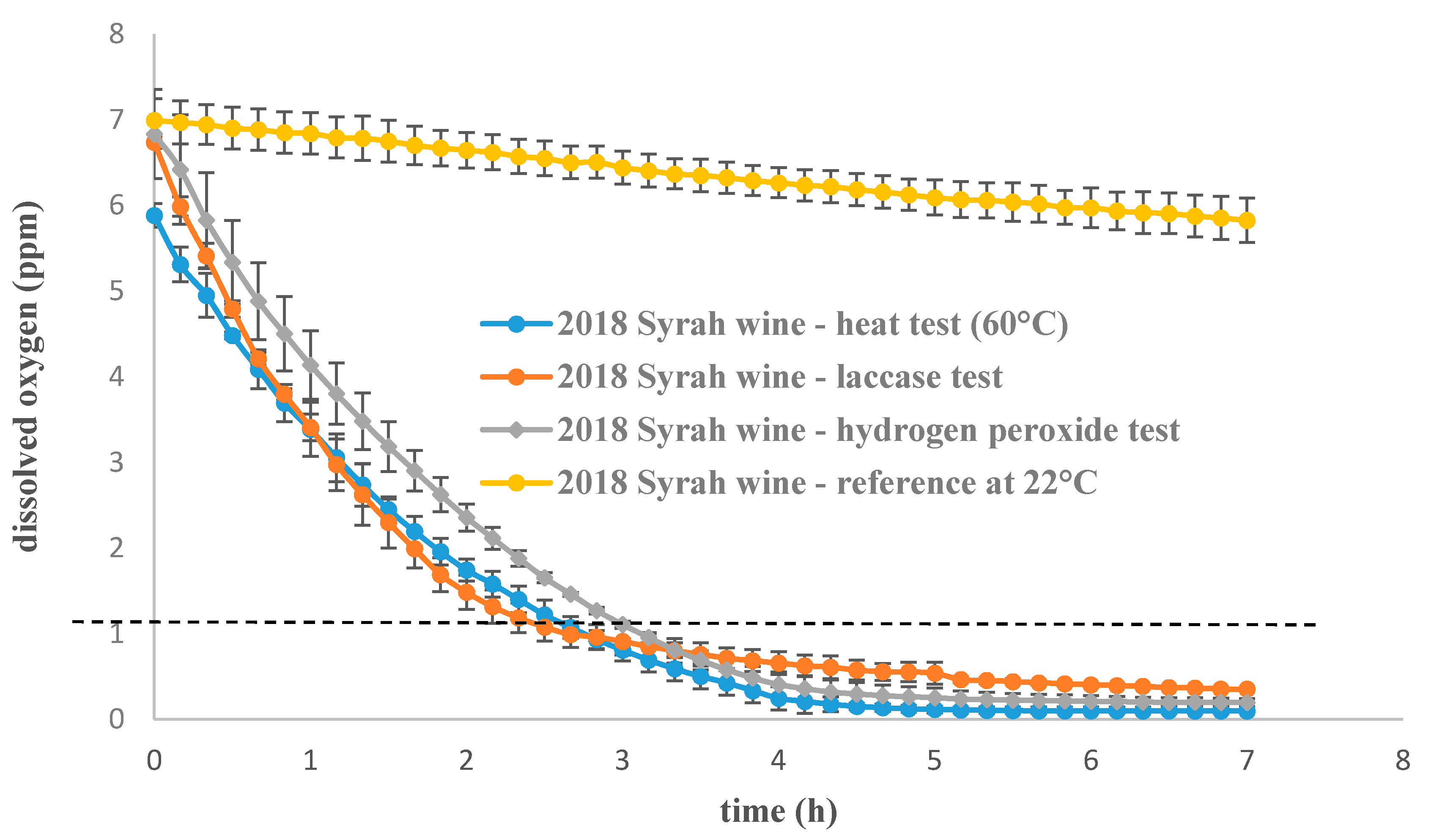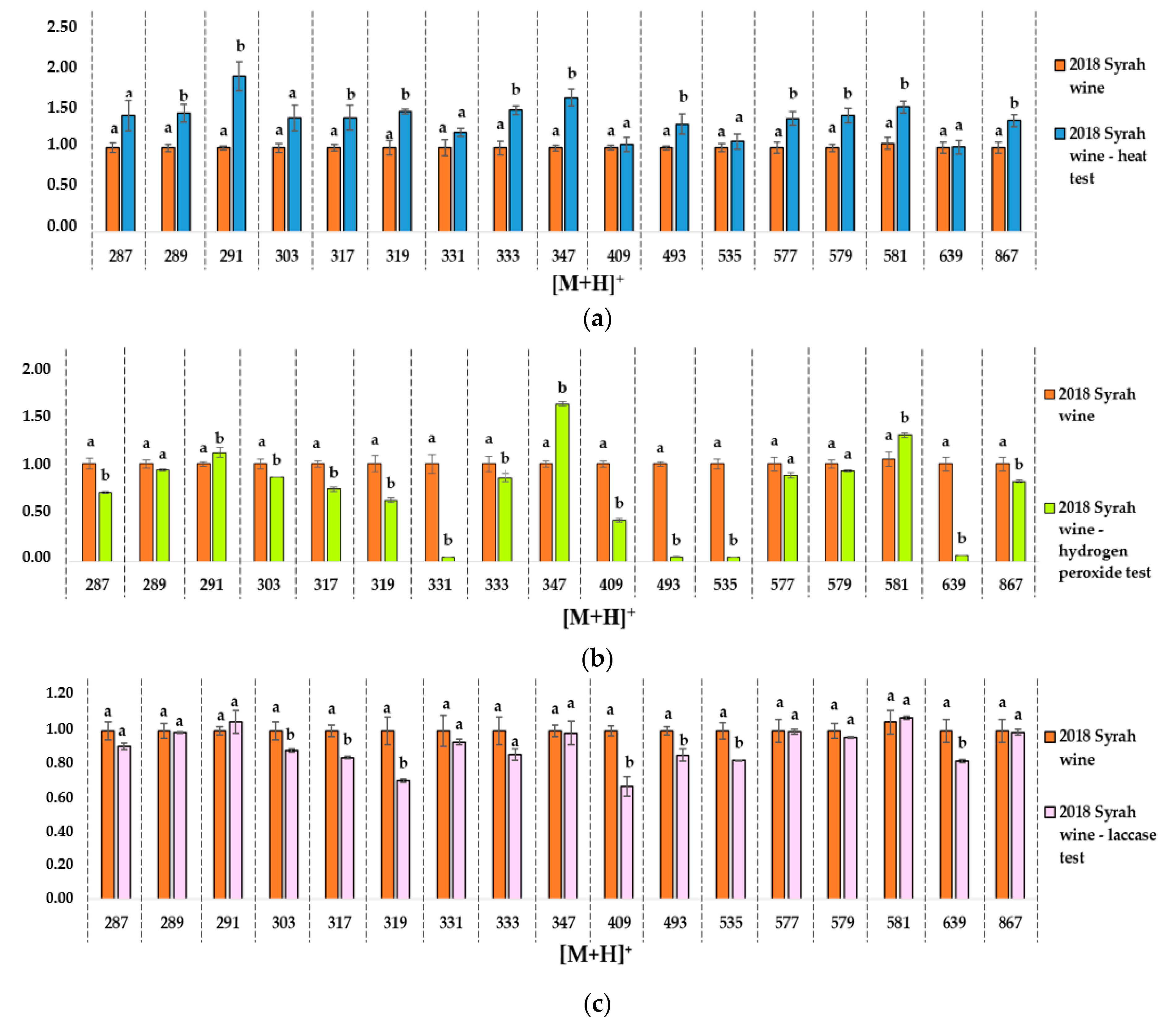Red Wine Oxidation: Accelerated Ageing Tests, Possible Reaction Mechanisms and Application to Syrah Red Wines
Abstract
:1. Introduction
- -
- To set up new and reproducible accelerated ageing tests for red wines.
- -
- Identify oxidation markers involved in these tests by LC-MS.
- -
- Apply the new tests to red wine samples from different vintages.
2. Materials and Methods
2.1. Materials
2.2. Model Wine Solution
2.3. Wine Samples
2.4. Wine Global Chemical Characterization
2.5. Accelerated Ageing Tests
2.6. UV–Visible Measurements
2.7. UPLC-ESI-Tof Parameters
2.8. Statistical Analysis
3. Results and Discussion
3.1. Set Up and Application of Three Different Forced Oxidation Protocols for Syrah Wine Samples (2018, 2014, 2010)
3.2. Colorimetric Analysis and Comparison of Three Untreated Wines from Different Vintages (2018, 2014 and 2010) and Three from 2018 Vintage Artificially Oxidized
3.3. UPLC-ESI-QTof
4. Conclusions
Supplementary Materials
Author Contributions
Funding
Conflicts of Interest
References
- Ferreira, V.; Bueno, M.; Franco-Luesma, E.; Culleré, L.; Fernández-Zurbano, P. Key Changes in wine aroma active compounds during bottle storage of spanish red wines under different oxygen levels. J. Agric. Food Chem. 2014, 62, 10015–10027. [Google Scholar] [CrossRef] [PubMed]
- Gambuti, A.; Siani, T.; Picariello, L.; Rinaldi, A.; Lisanti, M.T.; Ugliano, M.; Dieval, J.B.; Moio, L. Oxygen exposure of tannins-rich red wines during bottle aging. influence on phenolics and color, astringency markers and sensory attributes. Eur. Food Res. Technol. 2017, 243, 669–680. [Google Scholar] [CrossRef]
- Ugliano, M. Oxygen contribution to wine aroma evolution during bottle aging. J. Agric. Food Chem. 2013, 61, 6125–6136. [Google Scholar] [CrossRef] [PubMed]
- Caillé, S.; Samson, A.; Wirth, J.; Diéval, J.-B.; Vidal, S.; Cheynier, V. Sensory characteristics changes of red grenache wines submitted to different oxygen exposures pre and post bottling. Anal. Chim. Acta 2010, 660, 35–42. [Google Scholar] [CrossRef]
- Gambuti, A.; Rinaldi, A.; Ugliano, M.; Moio, L. Evolution of phenolic compounds and astringency during aging of red wine: Effect of oxygen exposure before and after bottling. J. Agric. Food Chem. 2013, 61, 1618–1627. [Google Scholar] [CrossRef]
- De Beer, D.; Joubert, E.; Marais, J.; du Toit, W.; Fouché, B.; Manley, M. Characterisation of pinotage wine during maturation on different oak products. South Afr. J. Enol. Vitic. 2016, 29. [Google Scholar] [CrossRef] [Green Version]
- Cheynier, V.; Dueñas-Paton, M.; Salas, E.; Maury, C.; Souquet, J.-M.; Sarni-Manchado, P.; Fulcrand, H. Structure and properties of wine pigments and tannins. Am. J. Enol. Vitic. 2006, 57, 298–305. [Google Scholar]
- Oliveira, C.M.; Ferreira, A.C.S.; De Freitas, V.; Silva, A.M.S. Oxidation mechanisms occurring in wines. Food Res. Int. 2011, 44, 1115–1126. [Google Scholar] [CrossRef]
- Somers, T.C.; Wescombe, L.G. Evolution of red wines II. an assessment of the role of acetaldehyde. VITIS J. Grapevine Res. 1987, 26, 27. [Google Scholar]
- Singleton, V.L. Oxygen with phenols and related reactions in musts, wines, and model systems: Observations and practical implications. Am. J. Enol. Vitic. 1987, 38, 9. [Google Scholar]
- Kilmartin, P.A. The oxidation of red and white wines and its impact on wine aroma. Res. Gate 2009, 73. [Google Scholar]
- Waterhouse, A.L.; Laurie, V.F. Oxidation of wine phenolics: A critical evaluation and hypotheses. Am. J. Enol. Vitic. 2006, 57, 306–313. [Google Scholar]
- Ployon, S.; Attina, A.; Vialaret, J.; Walker, A.S.; Hirtz, C.; Saucier, C. Laccases 2 & 3 as biomarkers of botrytis cinerea infection in sweet white wines. Food Chem. 2020, 315, 126233. [Google Scholar] [CrossRef] [PubMed]
- Nikolantonaki, M.; Waterhouse, A.L. A method to quantify quinone reaction rates with wine relevant nucleophiles: A key to the understanding of oxidative loss of varietal thiols. J. Agric. Food Chem. 2012. [Google Scholar] [CrossRef] [PubMed]
- Nikolantonaki, M.; Magiatis, P.; Waterhouse, A.L. Measuring protection of aromatic wine thiols from oxidation by competitive reactions vs wine preservatives with ortho-quinones. Food Chem. 2014, 163, 61–67. [Google Scholar] [CrossRef] [PubMed]
- Fulcrand, H.; Dueñas, M.; Salas, E.; Cheynier, V. Phenolic reactions during winemaking and aging. Am. J. Enol. Vitic. 2006, 57, 289–297. [Google Scholar]
- Danilewicz, J.C.; Seccombe, J.T.; Whelan, J. Mechanism of interaction of polyphenols, oxygen, and sulfur dioxide in model wine and wine. Am. J. Enol. Vitic. 2008, 59, 128–136. [Google Scholar]
- Ma, L.; Watrelot, A.A.; Addison, B.; Waterhouse, A.L. Condensed tannin reacts with SO2 during wine aging, yielding flavan-3-ol sulfonates. J. Agric. Food Chem. 2018, 66, 9259–9268. [Google Scholar] [CrossRef]
- Elias, R.J.; Waterhouse, A.L. Controlling the fenton reaction in wine. J. Agric. Food Chem. 2010, 58, 1699–1707. [Google Scholar] [CrossRef]
- Petrozziello, M.; Torchio, F.; Piano, F.; Giacosa, S.; Ugliano, M.; Bosso, A.; Rolle, L. Impact of increasing levels of oxygen consumption on the evolution of color, phenolic, and volatile compounds of nebbiolo wines. Front. Chem. 2018, 6. [Google Scholar] [CrossRef]
- Ferreira, V.; Carrascon, V.; Bueno, M.; Ugliano, M.; Fernandez-Zurbano, P. Oxygen consumption by red wines. part I: Consumption rates, relationship with chemical composition, and role of SO2. J. Agric. Food Chem. 2015, 63, 10928–10937. [Google Scholar] [CrossRef] [PubMed]
- Castro, C.C.; Martins, R.C.; Teixeira, J.A.; Silva Ferreira, A.C. Application of a high-throughput process analytical technology metabolomics pipeline to port wine forced ageing process. Food Chem. 2014, 143, 384–391. [Google Scholar] [CrossRef] [PubMed] [Green Version]
- Zou, H.; Kilmartin, P.A.; Inglis, M.J.; Frost, A. Extraction of phenolic compounds during vinification of pinot noir wine examined by hplc and cyclic voltammetry. Aust. J. Grape Wine Res. 2002, 8, 163–174. [Google Scholar] [CrossRef]
- Gil, M.; Reynes, C.; Cazals, G.; Enjalbal, C.; Sabatier, R.; Saucier, C. Discrimination of rosé wines using shotgun metabolomics with a genetic algorithm and ms ion intensity ratios. Sci. Rep. 2020, 10. [Google Scholar] [CrossRef] [PubMed] [Green Version]
- Macías, V.M.P.; Pina, I.C.; Rodríguez, L.P. Factors influencing the oxidation phenomena of sherry wine. Am. J. Enol. Vitic. 2001, 52, 151–155. [Google Scholar]
- Kumar, K.; Ajar, N.Y.; Pritesh, V.; Singh, K. Chemical changes in food during processing and storage. Res. Gate 2016. [Google Scholar] [CrossRef]
- Carbonneau, A.; Deloire, A.; Torregrosa, L.; Jaillard, B.; Pellegrino, A.; Metay, A.; Ojeda, H.; Lebon, E.; Abbal, P. Traité de La Vigne: Physiologie, Terroir, Culture; Dunod: Malakoff, France, 2015. [Google Scholar]
- Tanaka, Y.; Sasaki, N.; Ohmiya, A. Biosynthesis of plant pigments: Anthocyanins, betalains and carotenoids. Plant J. 2008, 54, 733–749. [Google Scholar] [CrossRef]
- Aurelio, D.-L.; Edgardo, R.G.; Navarro-Galindo, S. Thermal kinetic degradation of anthocyanins in a roselle (hibiscus sabdariffa l. cv. ‘criollo’) infusion. Int. J. Food Sci. Technol. 2008, 43, 322–325. [Google Scholar] [CrossRef]
- Redus, M.; Baker, D.C.; Dougall, D.K. Rate and equilibrium constants for the dehydration and deprotonation reactions of some monoacylated and glycosylated cyanidin derivatives. J. Agric. Food Chem. 1999, 47, 3449–3454. [Google Scholar] [CrossRef]
- Piffaut, B.; Kader, F.; Girardin, M.; Metche, M. Comparative degradation pathways of malvidin 3,5-diglucoside after enzymatic and thermal treatments. Food Chem. 1994, 50, 115–120. [Google Scholar] [CrossRef]
- Lopes, P.; Richard, T.; Saucier, C.; Teissedre, P.-L.; Monti, J.-P.; Glories, Y. Anthocyanone a: A quinone methide derivative resulting from malvidin 3- o -glucoside degradation. J. Agric. Food Chem. 2007, 55, 2698–2704. [Google Scholar] [CrossRef] [PubMed]
- Carrascón, V.; Vallverdú-Queralt, A.; Meudec, E.; Sommerer, N.; Fernandez-Zurbano, P.; Ferreira, V. The kinetics of oxygen and so2 consumption by red wines. what do they tell about oxidation mechanisms and about changes in wine composition? Food Chem. 2018, 241, 206–214. [Google Scholar] [CrossRef] [PubMed] [Green Version]
- Singleton, V.L.; Kramlinga, T.E. Browning of white wines and an accelerated test for browning capacity. Am. J. Enol. Vitic. 1976, 27, 157–160. [Google Scholar]
- Jurd, L. Anthocyanidins and related compounds—XIII. Tetrahedron 1968, 24, 4449–4457. [Google Scholar] [CrossRef]
- Hrazdina, G. Oxidation of the anthocyanidin-3,5-diglucosides with H2O2: The structure of malvone. Phytochemistry 1970, 9, 1647–1652. [Google Scholar] [CrossRef]
- Hrazdina, G.; Franzese, A.J. Oxidation products of acylated anthocyanins under acidic and neutral conditions. Phytochemistry 1974, 13, 231–234. [Google Scholar] [CrossRef]
- Cheynier, V.; Ricardo da Silva, J.M. Oxidation of grape procyanidins in model solutions containing trans-caffeoyltartaric acid and polyphenol oxidase. J. Agric. Food Chem. 1991, 39, 1047–1049. [Google Scholar] [CrossRef]
- McDonald, P.D.; Hamilton, G.A. Mechanisms of Phenolic Oxidative Coupling Reactions. In Organic Chemistry; Elsevier: Amsterdam, The Netherlands, 1973; Volume 5, pp. 97–134. [Google Scholar] [CrossRef]
- Fulcrand, H.; Cheminat, A.; Brouillard, R.; Cheynier, V. Characterization of compounds obtained by chemical oxidation of caffeic acid in acidic conditions. Phytochemistry 1994, 35, 499–505. [Google Scholar] [CrossRef]
- Guyot, S.; Vercauteren, J.; Cheynier, V. Structural determination of colourless and yellow dimers resulting from (+)-catechin coupling catalysed by grape polyphenoloxidase. Phytochemistry 1996, 42, 1279–1288. [Google Scholar] [CrossRef]







| Oxidation Protocol | Oxygen Consumption Rate (ppm·h−1) |
|---|---|
| Heat test −60 °C | 2.40 ± 0.06 a |
| Laccase test | 3.33 ± 0.05 b |
| Hydrogen peroxide test | 2.86 ± 0.28 c |
| (a) | |
| Wine Sample | Oxygen Consumption Rate (ppm·h−1) |
| 2018 Syrah wine—heat test (60 °C) | 2.40 ± 0.06 a |
| 2014 Syrah wine—heat test (60 °C) | 1.77 ± 0.45 a |
| 2010 Syrah wine—heat test (60 °C) | 2.28 ± 0.28 a |
| (b) | |
| 2018 Syrah wine—hydrogen peroxide test | 2.86 ± 0.28 a |
| 2014 Syrah wine—hydrogen peroxide test | 4.41 ± 0.33 b |
| 2010 Syrah wine—hydrogen peroxide test | 3.65 ± 0.08 c |
| (c) | |
| 2018 Syrah wine—laccase test | 3.33 ± 0.06 a |
| 2014 Syrah wine—laccase test | 2.45 ± 0.34 b |
| 2010 Syrah wine—laccase test | 4.54 ± 0.66 c |
| Wine Sample | Abs 420 | Abs 520 | 420/520 |
|---|---|---|---|
| 2018 | 0.545 ± 0.002 a | 0.705 ± 0.003 a | 0.773 ± 0.001 a |
| 2014 | 0.499 ± 0.003 b | 0.508 ± 0.004 b | 0.982 ± 0.001 b |
| 2010 | 0.702 ± 0.006 c | 0.631 ± 0.006 c | 1.111 ± 0.001 c |
| 2018—heat test (60 °C) | 0.554 ± 0.002 a | 0.664 ± 0.003 d | 0.834 ± 0.002 a |
| 2018—hydrogen peroxide test | 0.435 ± 0.006 e | 0.318 ± 0.007 f | 1.365 ± 0.013 d |
| 2018—laccase test | 0.620 ± 0.02 d | 0.770 ± 0.025 e | 0.806 ± 0.002 a,b |
| [M+H]+ | Ion Annotation |
|---|---|
| 287 | Cyanidin, Kaempferol |
| 289 | Fragment from polymeric proanthocyanidin |
| 291 | (+)-catechin, (-)-epicatechin, Fragment from polymeric proanthocyanidin |
| 303 | Quercetin, delphinidin, fragment from quercetin 3-glucoside, fragment from quercetin glucuronide |
| 317 | Petunidin, isorhamnetin |
| 319 | Fragment from myricetin 3-glucoside, fragment from myricetin glucuronide |
| 331 | Malvidin |
| 333 | unknown |
| 347 | Syringetin |
| 409 | Retro Diels Alder fragment |
| 493 | Malvidin 3-O-glucoside |
| 535 | Malvidin 3-O-acetyl glucoside |
| 577 | Oxidized dimeric proanthocyanidin |
| 579 | Dimeric proanthocyanidin, p-hydroxyphenylpyranopeodin 3-O-glucoside |
| 581 | Oxidized dimeric proanthocyanidin |
| 639 | Guaiacylpyranomalvidin 3-O-glucoside |
| 867 | Trimeric proanthocyanidins |
© 2020 by the authors. Licensee MDPI, Basel, Switzerland. This article is an open access article distributed under the terms and conditions of the Creative Commons Attribution (CC BY) license (http://creativecommons.org/licenses/by/4.0/).
Share and Cite
Deshaies, S.; Cazals, G.; Enjalbal, C.; Constantin, T.; Garcia, F.; Mouls, L.; Saucier, C. Red Wine Oxidation: Accelerated Ageing Tests, Possible Reaction Mechanisms and Application to Syrah Red Wines. Antioxidants 2020, 9, 663. https://doi.org/10.3390/antiox9080663
Deshaies S, Cazals G, Enjalbal C, Constantin T, Garcia F, Mouls L, Saucier C. Red Wine Oxidation: Accelerated Ageing Tests, Possible Reaction Mechanisms and Application to Syrah Red Wines. Antioxidants. 2020; 9(8):663. https://doi.org/10.3390/antiox9080663
Chicago/Turabian StyleDeshaies, Stacy, Guillaume Cazals, Christine Enjalbal, Thibaut Constantin, François Garcia, Laetitia Mouls, and Cédric Saucier. 2020. "Red Wine Oxidation: Accelerated Ageing Tests, Possible Reaction Mechanisms and Application to Syrah Red Wines" Antioxidants 9, no. 8: 663. https://doi.org/10.3390/antiox9080663





